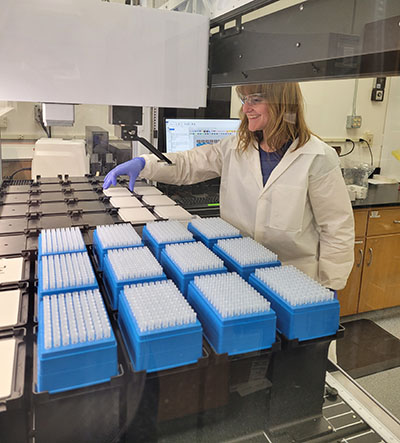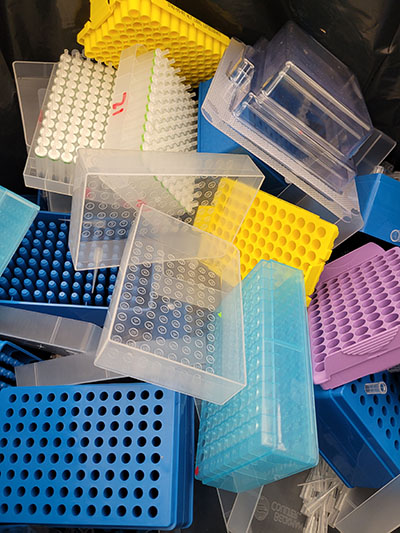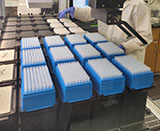Alaska Fish & Wildlife News
July 2024
Recycling in a Genetics Lab

Biologist Tela Barkley and her colleagues at the Gene Conservation Lab in Anchorage focus on fish genetics, providing important information for biologists and fishery managers. They extract DNA from thousands of tissue samples and investigate the genetic makeup of salmon and other commercially important fish. But one aspect of the work was concerning – it generates a lot of plastic waste. And that went into the landfill.
“The negative environmental impact of our plastic use was always on our minds,” Barkley said. “Washing and reusing plastics is not a feasible option due to the threat of contamination between samples.”
During a busy two-week period, the lab could generate a dozen big trash bags of plastic waste - two or three hundred pounds of plastic. Thousands of items: pipette tips (similar to eyedroppers), plastic boxes with clusters of 96 small test tubes, plastic binding plates and archive plates - most of which also come packaged in plastic boxes.
“There are probably 100,000 samples going through the lab in a year,” Barkley said. “Almost everything we use throughout the DNA extraction and genotyping process is single use, and all of it used to go in the trash.”
In the spring of 2023, her colleague Erica Chenoweth discovered another option.
“I was on maternity leave, waiting for my baby to come, and was looking at the ‘make it’ classroom at Habitat for Humanity,” Chenoweth said. “I stumbled on the publicity for an event that had already happened, an info session for Alaskan Recycled Plastic Lumber.”

She emailed her colleagues the information, “just in case there’s hope for recycling lab tip boxes among other plastics.” Barkley reached out to Patrick Simpson at Alaska Plastics Recovery to learn more. By the time Chenoweth returned to work in August, the ball was rolling.
“Most of the plastics in our lab are polypropylene, which is highly recyclable, and is very clean in comparison to the plastic ocean waste they collect, so we knew right away that it would be a good fit for both organization’s missions,” Barkley said.
Gene Conservation Laboratory
There are about 20 fishery biologists, geneticists and technicians in the commercial fisheries’ Gene Conservation Laboratory, with about 10 engaged in processing samples and genotyping in the lab at the Fish and Game office on Raspberry Road. They work with all five Pacific salmon species (including Bristol Bay sockeye) as well as some rockfish, shellfish and eventually, even seaweed. They also co-manage an at-sea lab onboard a research fishing vessel in summer in Bristol Bay, and in the rare event of a bear mauling, they analyze DNA samples to help identify the specific animal involved.

Biologists in the field and on the water take samples, such as a clip of a sockeye salmon’s fin, and send them to Anchorage. After DNA is extracted the genetic makeup is examined (genotyping); a biologist compares it to an archive of genetic baselines and can match it to the stock of salmon that spawns in a certain river. Sockeye in Bristol Bay spawn in nine major drainages around the bay, and genotyping can identify the stock.
“The genotyping after the DNA is extracted is where the bulk of the waste comes from,” Barkley said.
After a few weeks of work, that plastic could fill the bed of a pickup truck.
“We don’t have to sort the plastic here, they just take it all,” Barkley said. In the past, she called Alaska Plastic Recovery and they came and picked up the material, but they are establishing a location where people can drop off the materials
The Alaska-based company started out collecting ocean debris, she said. The company began in 2020 and was originally called Plastic Ocean Waste Solutions, acquiring material from ocean debris clean-up efforts, as well as residential recycling programs. The company was renamed Alaska Plastic Recovery in 2022 to represent the broader range of plastic sources. Five of the seven types of common consumer plastic are recycled (excluding #3 and #6).

The plastic is converted into construction products, plastic bricks and plastic lumber they call Grizzly Wood. The processing facility is mobile and can move from community to community as needed – so generally speaking, this recycling process doesn’t require that collected material is shipped out, and that the recycled new material is shipped back. The company is also currently processing plastic in Seward, Soldotna, and Palmer.
Recycling is growing at the Fish and Game office in Anchorage, which serves as the regional office for much of Southcentral Alaska and the base for a number of statewide programs. Plastic goes into recycling bins in the breakrooms. Barkley has also expanded the program to include another lab.
“I have been working with the Pathology lab here to collect their plastics as well,” she said.
Editors note: the mention of specific products and companies is not an endorsement.
Subscribe to be notified about new issues
Receive a monthly notice about new issues and articles.
